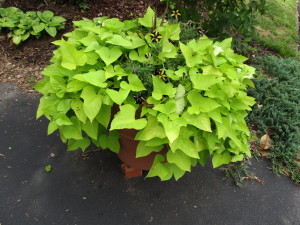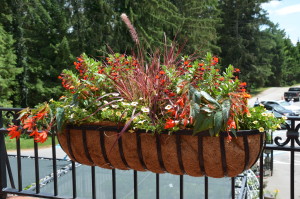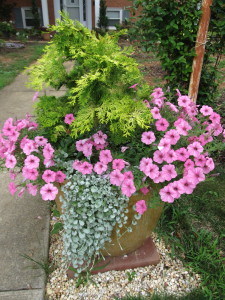As more and more urban gardeners are growing in small spaces, including decks and patio of condos and town houses, container gardens are becoming more significant. They’re creating large mixed containers that include miniature trees and shrubs rather than their big cousins.
For design containers may include thrillers (tall or spiky), fillers, and spillers (weepers). They contain splashes of color or many color contrasts.
Here is a few design ideas that blend shrubs/trees, perennials, and annuals together for great effect:
- Container size is of key important. Large, wide (broad base) containers are the best to avoid tipover from high winds. Halved wine barrels or large concrete planters are good choices for a permanent fixture, as their weight ensures that they won’t get blown over easily. Containers must have one or more drainage holes or a 3-4 inch reservoir containing coarse pea gravel.
- Use a miniature tree or shrub as the tallest feature in the planter. Include woody landscape trees and shrubs such as: dwarf columnar conifers, Japanese maple (Acer), camellias, buddleia, hydrangeas, or crapemytle (Lagerstroemia).
- Use annuals to add bold color(s) to the display. Great selections to handle the summer heat include: begonias, calibrachoas, impatiens, annual vincas (Catharanthus roseus), scaevolas, and Mexican heather (Cuphea hyssopifolia).
- Include perennials to fill in spaces and that add their own lovely color and contrast. Some of the best perennials for this role are: coral bells (Heuchera), miniature and small leaved hostas, sedges (Carex), sweet flag (Acorus), monkeygrass (Liriope), and assorted ferns.
- Use plants with similar growing conditions, e.g. in partial to full sun or shade or moist or dry potting soil.
- Use a mixture of early-, mid-, and late-season blooming plants to ensure a colorful display all season long.
- Check plant hardiness of woody plants in your area to add to container.
Growing Tips: woody landscape trees and shrubs and some perennials need to be transplanted every 2-3 years in late winter. Replace the soil (media) and root and shoot old plants before adding new soil (media). Feed with a slow release fertilizer such as Osmocote™, Scotts™, and Nutricote™.




 Posted in
Posted in 
